Las cubiertas de acero se han convertido en un elemento vital en los proyectos de construcción, ya que ofrecen una resistencia y versatilidad superiores. Comprender las dimensiones de las cubiertas de acero es crucial seleccionar los materiales adecuados para su proyecto. Tanto si trabaja en edificios comerciales como en espacios residenciales o industriales, las cubiertas de acero son una solución eficaz para crear sólidos sistemas de suelo y techo. Pero, ¿en qué consiste exactamente la tarima de acero? ¿Cómo se miden las dimensiones y qué variaciones debe conocer? Sumerjámonos en el mundo de las cubiertas de acero para explorar sus dimensiones, tipos y funcionamiento.
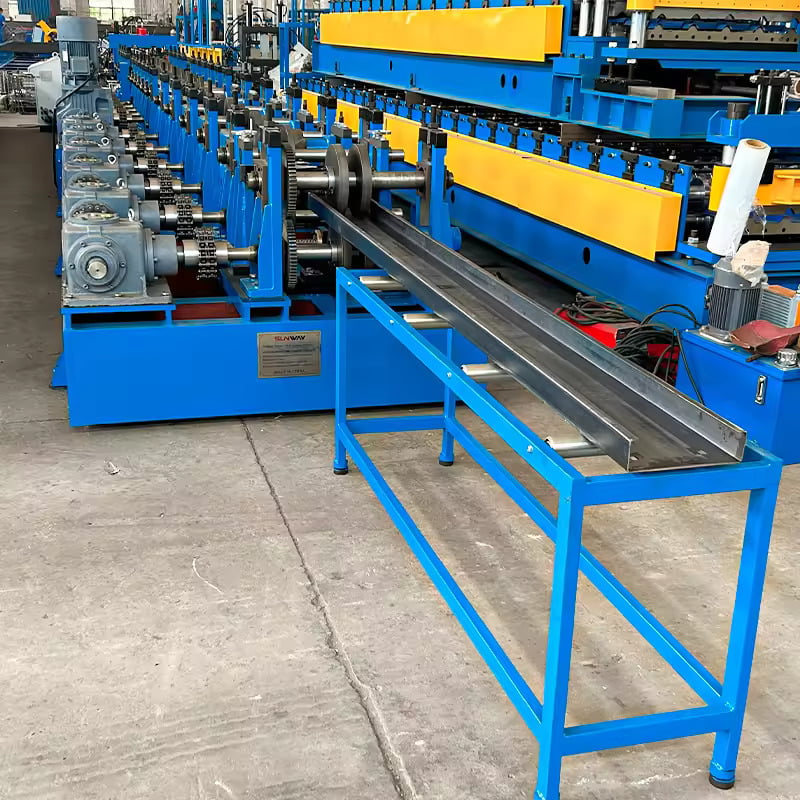
Dimensiones de las cubiertas de acero
Las dimensiones de las cubiertas de acero se refieren al tamaño, grosor y otras medidas de los paneles de cubierta de acero utilizados en proyectos de construcción. Estas cubiertas suelen estar hechas de chapas de acero corrugado, a las que se da forma de crestas y ranuras para aumentar su resistencia y rigidez. Las cubiertas de acero se utilizan principalmente en sistemas de suelos, estructuras de tejados, entreplantas y encofrados para losas de hormigón.
A la hora de elegir una cubierta de acero, es fundamental comprender las distintas dimensiones y cómo influyen en la funcionalidad de su proyecto. Varios factores, como el grosor, la anchura, la altura de los nervios y la profundidad total, definen la calidad y la utilidad de la cubierta de acero.
Principales ventajas de las cubiertas de acero
- Relación resistencia-peso: Las cubiertas de acero son ligeras pero increíblemente resistentes, lo que facilita su transporte e instalación sin sacrificar su durabilidad.
- Flexibilidad en el diseño: Las cubiertas de acero se presentan en una amplia gama de tamaños y formas, lo que permite personalizarlas en función de las necesidades específicas de su proyecto.
- Rentabilidad: En comparación con otros materiales para suelos o cubiertas, la tarima de acero es más asequible en términos de costes de material y mano de obra.
- Resistencia al fuego: El acero, por naturaleza, es incombustible, lo que añade una capa de seguridad contra incendios a la estructura.
- Sostenibilidad: El acero es altamente reciclable, lo que lo convierte en una opción respetuosa con el medio ambiente.
Profundicemos ahora en los aspectos fundamentales de las dimensiones de las cubiertas de acero para comprender mejor su proceso de trabajo, sus componentes clave y cómo encajan en las distintas aplicaciones de la construcción.
Chapas de acero corrugado: Una guía
Las chapas onduladas se suelen utilizar para cubiertas de acero por su diseño ondulado, que aumenta la resistencia y la capacidad de carga. Estas chapas se fabrican haciendo pasar chapas de acero planas por una serie de rodillos, formando un patrón de crestas y valles. Las chapas onduladas suelen galvanizarse o recubrirse con una capa protectora para evitar la oxidación y la corrosión.
Cómo se fabrican las chapas onduladas
El proceso de fabricación comienza con el laminado de bobinas de acero en láminas planas. A continuación, estas chapas pasan por una serie de rodillos perfilados para formar el perfil ondulado. Después, las chapas de acero pueden someterse a procesos de galvanización o revestimiento, en los que se sumergen en zinc u otros materiales protectores.
Las dimensiones de las chapas onduladas de acero varían en función del grosor (medido en galgas), la altura de los nervios y la anchura total del panel. Estos factores influyen en la capacidad de carga de la chapa, por lo que es fundamental seleccionar las dimensiones adecuadas en función de sus necesidades estructurales.
Tipos de cubiertas de acero y sus dimensiones
Existen varios tipos de cubiertas de acero, cada una diseñada para un fin específico. A continuación se muestra una tabla con los diferentes tipos de cubiertas de acero y sus dimensiones comunes.
| Tipo de cubierta de acero | Altura de la costilla (pulgadas) | Espesor (galga) | Anchura (pulgadas) | Utiliza |
|---|---|---|---|---|
| Encofrado | 1.5 | 22 a 16 | 36 a 48 | Se utiliza como encofrado para suelos de hormigón |
| Suelos compuestos | 2 a 3 | 18 a 20 años | 36 a 48 | Proporciona un refuerzo adicional |
| Cubiertas | 1 a 1,5 | 20 a 22 | 36 a 42 | Para crear sistemas de cubiertas |
| Tarima celular | 2 a 3 | 16 a 18 años | 36 a 48 | Ofrece espacios ocultos para el cableado |
| Cubierta profunda | 3 a 4,5 | 16 a 20 años | 36 a 48 | Alta resistencia para estructuras de grandes luces |
| Tarimas acústicas | 2 a 3 | 18 a 22 años | 36 a 48 | Insonorización de espacios acústicamente sensibles |
Cada tipo de tarima tiene sus aplicaciones específicas. Por ejemplo, suelos compuestos suele elegirse para suelos que requieren una capacidad de carga adicional, mientras que cubierta del tejado es más adecuado para sistemas de techado debido a su capacidad para soportar materiales de aislamiento y techado.
Proceso de trabajo de las dimensiones de la cubierta de acero
El proceso de trabajo para seleccionar e instalar las dimensiones de la cubierta de acero implica varios pasos. He aquí un resumen del flujo de trabajo, desde la selección del tipo adecuado de cubierta de acero hasta la instalación.
Paso 1: Determinar las necesidades de carga
El primer paso para elegir las dimensiones correctas de la cubierta de acero es evaluar los requisitos de carga de su proyecto. Esto incluye tanto la carga muerta (el peso de la cubierta y otras estructuras permanentes) como la carga viva (el peso de personas, muebles o equipos).
Paso 2: Seleccione el tipo de tarima
En función de los requisitos de carga, seleccionará el tipo de tarima adecuado, ya sea una tarima encofrante para suelos de hormigón, una tarima compuesta para estructuras reforzadas o una tarima de tejado para sistemas de cubierta.
Paso 3: Medir y calcular las dimensiones
Una vez seleccionado el tipo, el siguiente paso es determinar las dimensiones adecuadas. Entre los factores que hay que tener en cuenta figuran:
- Grosor: Las cubiertas de acero más gruesas proporcionan más resistencia, pero son más pesadas.
- Anchura: Los paneles más anchos cubren más superficie, pero pueden requerir soportes adicionales.
- Altura de las costillas: Las costillas más altas mejoran la capacidad de carga de la cubierta.
Paso 4: Instalar la cubierta de acero
La instalación consiste en colocar la tarima de acero sobre las vigas de soporte, asegurándose de que los paneles se solapan correctamente para aumentar su resistencia. A continuación, la cubierta se fija mediante fijaciones mecánicas o técnicas de soldadura.
Paso 5: Añadir hormigón o materiales de cubierta
Para los suelos, se vierte hormigón sobre la cubierta de acero para formar una losa compuesta. En los tejados, se aplican materiales aislantes e impermeabilizantes sobre la cubierta de acero.
-
 Máquina formadora de rollos de marco de gabinete eléctrico
Máquina formadora de rollos de marco de gabinete eléctrico -
 Máquina formadora de rollos de riel DIN
Máquina formadora de rollos de riel DIN -
 Máquina formadora de rollos de escalera de cable
Máquina formadora de rollos de escalera de cable -
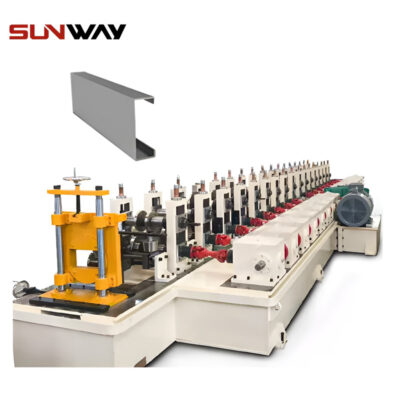 Máquina formadora de rollos de perfil en forma de C con soporte de montaje fotovoltaico
Máquina formadora de rollos de perfil en forma de C con soporte de montaje fotovoltaico -
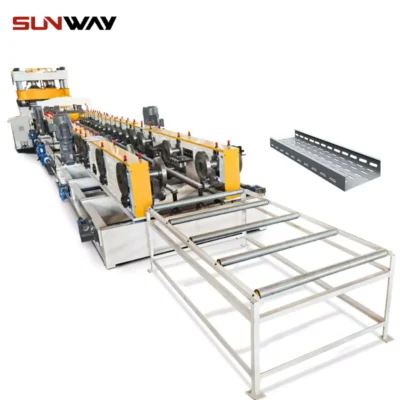 Máquina perfiladora de bandeja portacables
Máquina perfiladora de bandeja portacables -
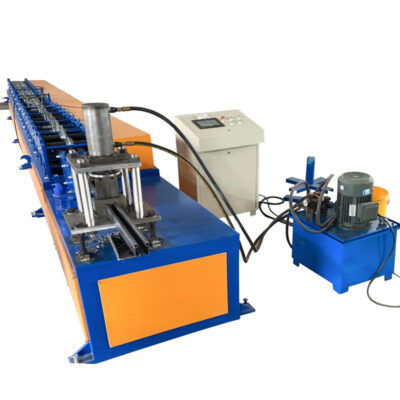 Máquina formadora de rollos de ángulo de pared de quilla ligera Máquina formadora de ángulo de pared de esquinas protectoras
Máquina formadora de rollos de ángulo de pared de quilla ligera Máquina formadora de ángulo de pared de esquinas protectoras -
 Máquina formadora de rollos de hierro con ángulo de quilla en V
Máquina formadora de rollos de hierro con ángulo de quilla en V -
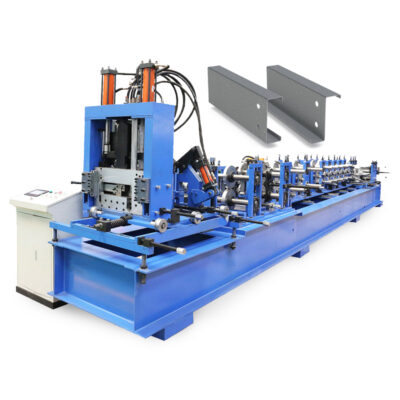 Máquina completamente automática de correas CZ Máquinas de marcos y correas de metal de acero
Máquina completamente automática de correas CZ Máquinas de marcos y correas de metal de acero -
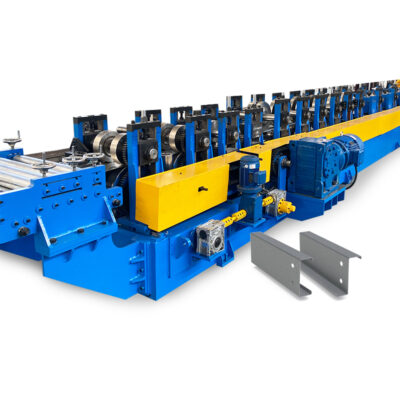 Completamente automática Hidráulica Fácil operación 80-300 Ajustable C Purlin que hace la máquina Maquinaria perfiladora
Completamente automática Hidráulica Fácil operación 80-300 Ajustable C Purlin que hace la máquina Maquinaria perfiladora
Componentes clave de la cubierta de acero y sus funciones
Cuando trabaje con cubiertas de acero, comprender los componentes clave y sus funciones le ayudará a garantizar el éxito de la instalación. A continuación se muestra una tabla detallada en la que se destacan estos componentes.
| Componente | Función |
|---|---|
| Chapas de acero | Material de base para la tarima, que proporciona la resistencia y rigidez primarias. |
| Costillas | Crestas onduladas que aumentan la capacidad de carga y la integridad estructural de la cubierta. |
| Fijaciones | Pernos, tornillos o soldaduras utilizados para fijar la cubierta de acero a la estructura de soporte. |
| Hormigón (para suelos) | Crea una losa compuesta cuando se vierte sobre el entarimado de acero, añadiendo resistencia y estabilidad. |
| Aislamiento (para tejados) | Proporciona aislamiento térmico y acústico, mejorando la eficiencia energética. |
| Espárragos soldados | Se utiliza en cubiertas compuestas para conectar la cubierta de acero con el hormigón, mejorando la transferencia de cargas. |
Velocidad y eficacia de las máquinas en la fabricación de cubiertas de acero
El proceso de fabricación de cubiertas de acero requiere máquinas de alta eficacia para garantizar una producción precisa y rápida. La tabla siguiente ilustra los parámetros habituales de las máquinas.
| Máquina | Velocidad (m/min) | Eficacia (%) | Solicitud |
|---|---|---|---|
| Máquina formadora de rollos | 10-20 | 85-90 | Se utiliza para crear perfiles ondulados |
| Galvanizadora | 8-15 | 80-85 | Recubrimiento de chapas de acero con capas protectoras |
| Máquina de corte | 15-25 | 90-95 | Corte de cubiertas de acero a la longitud deseada |
Personalización de las dimensiones de la cubierta de acero: Parámetros mecánicos
En algunos casos, los proyectos de construcción requieren cubiertas de acero con dimensiones personalizadas. A continuación se indican algunos parámetros mecánicos que pueden ajustarse durante el proceso de fabricación.
| Parámetro | Valor estándar | Gama personalizable |
|---|---|---|
| Espesor (galga) | 22 | 16 a 22 años |
| Altura de la costilla | 1,5 pulgadas | 1 a 4 pulgadas |
| Anchura del panel | 36 pulgadas | 36 a 48 pulgadas |
| Longitud | 3 metros | 6 a 20 pies |
Aplicaciones de las cubiertas de acero
El entarimado de acero se utiliza en diversos proyectos de construcción, como suelos, tejados y entreplantas. Aquí encontrará una tabla detallada con las aplicaciones más comunes.
| Solicitud | Tipo de cubierta de acero | Ventajas |
|---|---|---|
| Suelos de edificios comerciales | Suelos compuestos | Proporciona resistencia y flexibilidad para zonas de gran carga |
| Cubiertas residenciales | Cubiertas | Ligero y resistente al fuego |
| Entreplantas | Tarima celular | Permite espacios ocultos para el cableado eléctrico |
| Aparcamientos | Cubierta profunda | Soporta cargas pesadas y grandes luces |
Instalación, funcionamiento y mantenimiento de cubiertas de acero
Una instalación adecuada y un mantenimiento regular son cruciales para garantizar la longevidad de las cubiertas de acero. En la tabla siguiente se describen las directrices de instalación, funcionamiento y mantenimiento.
| Fase | Actividades principales |
|---|---|
| Instalación | Alinee y fije las cubiertas de acero con fijaciones o soldaduras; asegúrese de que se solapan para aumentar la resistencia. |
| Operación | Asegúrese de que la cubierta soporta las cargas diseñadas e inspecciónela en busca de signos de desgaste. |
| Mantenimiento | Limpiar e inspeccionar en busca de óxido, repintar o volver a galvanizar si es necesario. |
Elección del proveedor de cubiertas de acero
Seleccionar al proveedor adecuado puede marcar una diferencia significativa en el éxito de su proyecto. Esto es lo que debe tener en cuenta:
| Factor | Consideraciones |
|---|---|
| Reputación | Busque proveedores con buenas críticas y un historial de fiabilidad |
| Opciones de personalización | Asegúrese de que ofrecen tamaños a medida si su proyecto requiere dimensiones no estándar |
| Velocidad de entrega | Pregunte por los plazos de entrega para evitar retrasos en los proyectos |
| Costo | Compare precios entre proveedores para obtener la mejor relación calidad-precio sin sacrificar la calidad |
Información sobre proveedores y precios
La siguiente tabla muestra algunos de los principales proveedores de cubiertas de acero y sus precios.
| Proveedor | Gama de precios (por pie cuadrado) | Características notables |
|---|---|---|
| ABC Techos Metálicos | $2,50 a $5,00 | Ofrece tamaños personalizados y entrega rápida |
| Steel Deck Direct | $3.00 a $6.50 | Especialista en cubiertas profundas de gran envergadura |
| Soluciones para cubiertas metálicas | $2,75 a $5,25 | Ofrece opciones de galvanización y color |
Cómo elegir el mejor proveedor de cubiertas de acero
A la hora de elegir el mejor proveedor, es esencial sopesar los pros y los contras de cada opción. Tenga en cuenta factores como el coste, los plazos de entrega, la personalización y el servicio de atención al cliente. He aquí una comparación entre dos proveedores líderes:
| Proveedor | Pros | Contras |
|---|---|---|
| ABC Techos Metálicos | Precios asequibles, plazos de entrega rápidos | Selección limitada de suelos profundos |
| Steel Deck Direct | Productos de alta calidad, excelente servicio al cliente | Precios ligeramente superiores a los de la competencia |
Ventajas y limitaciones de las cubiertas de acero
Las tarimas de acero ofrecen numerosas ventajas, pero también tienen algunas limitaciones.
| Ventajas | Limitaciones |
|---|---|
| Resistente, ligero y duradero | Requiere un mantenimiento regular para evitar la corrosión |
| Resistente al fuego y ecológico | Mayor coste inicial en comparación con las opciones de madera u hormigón |
| Personalizable para diversas aplicaciones | Puede requerir aislamiento adicional para el rendimiento térmico |
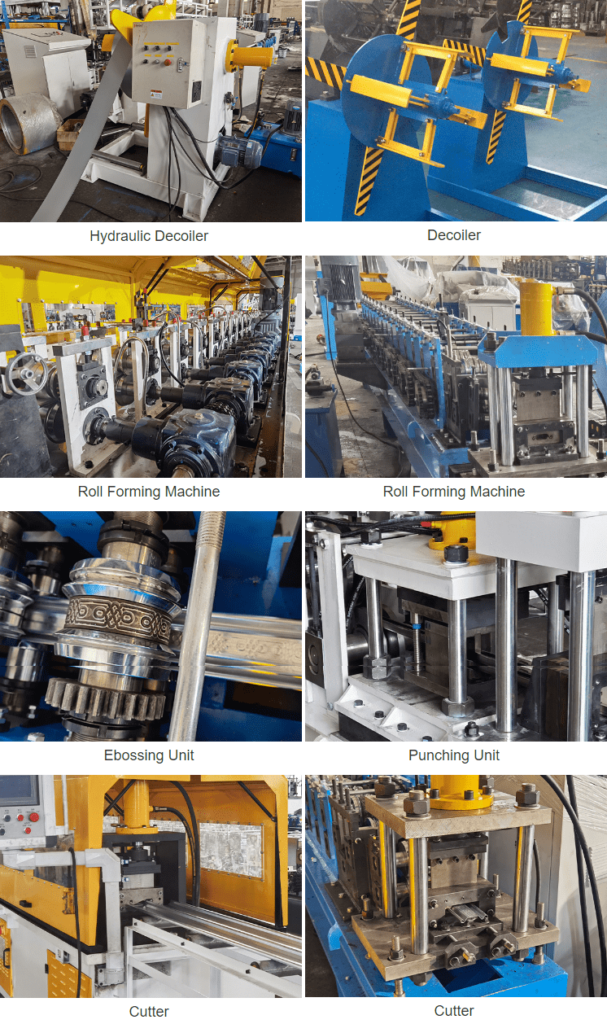
Preguntas más frecuentes
| Pregunta | Respuesta |
|---|---|
| ¿Cuáles son las dimensiones estándar de las tarimas de acero? | Las anchuras estándar oscilan entre 36 y 48 pulgadas, con espesores entre 16 y 22 galgas. |
| ¿Cómo se instalan las tarimas de acero? | Las cubiertas de acero se instalan alineándolas sobre vigas de soporte y fijándolas con tornillos o soldaduras. |
| ¿Se pueden personalizar las cubiertas de acero? | Sí, muchos fabricantes ofrecen tamaños a medida para satisfacer los requisitos específicos de un proyecto. |
| ¿Qué tipo de cubierta de acero es mejor para tejados? | La cubierta de tejado, más fina y ligera, es ideal para aplicaciones de techado. |
En conclusión, comprender la dimensiones de las cubiertas de acero es vital para el éxito de cualquier proyecto de construcción. Desde la elección del tipo de cubierta adecuado hasta la consideración del grosor, la altura de los nervios y la anchura, las cubiertas de acero ofrecen versatilidad, resistencia y durabilidad en una gran variedad de aplicaciones.
